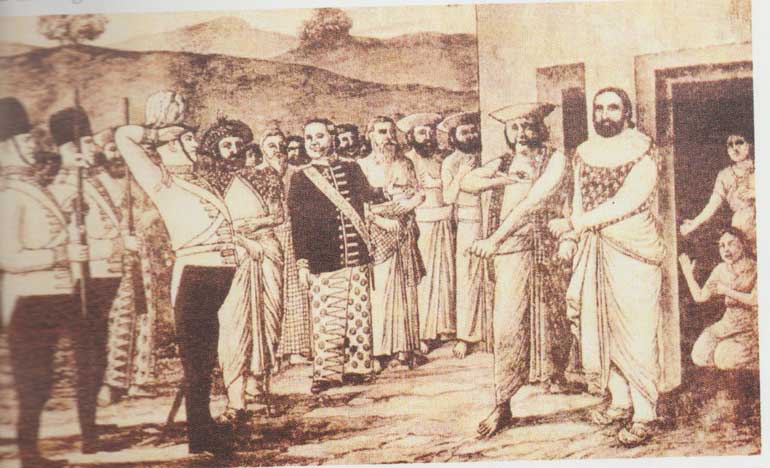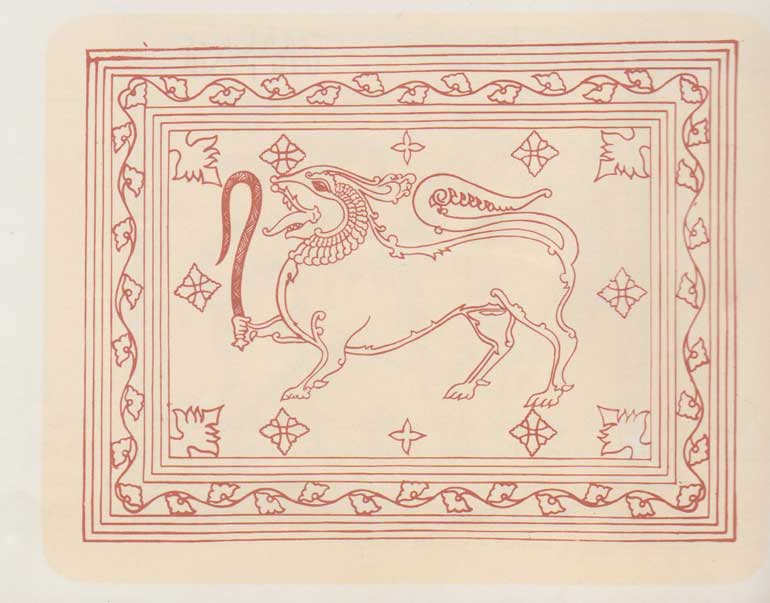Saturday Mar 29, 2025
Saturday Mar 29, 2025
Saturday, 19 March 2016 00:00 - - {{hitsCtrl.values.hits}}

Nothing can be more picturesque than the situation and aspect of Kandy, on the banks of a miniature lake, overhung on all sides by hills, which command charming views of the city with its temples, and monuments below. In the lake, a tiny island is covered by a picturesque building, now a powder magazine, but in former times a harem of the king. A road, which beards the name of Lady Horton’s Walk, winds round over one of those hills, and on the eastern side, which is steep and almost precipitous, it looks down into the valley of Doombara, through which the Mahaweli-Ganga rolls over a channel of rocks, presenting a scene which nothing in the tropics can exceed in majestic beauty – Sir Emerson Tennent in ‘Ceylon’ Vol II (1859)

Sri Vickrema Rajasinghe, the last king of Kandy, is captured by the British Rifle Company under Lt. Mylius
By D.C. Ranatunga
Tomorrow (20) marks the 150th anniversary of the Kandy Municipal Council. Kandy was the second city to gain municipal status under the Municipal Ordinance of 1865 passed during the administration of British Governor Sir Hercules Robinson (1865-72). The first was Colombo (1865) and Galle was to follow Kandy.
The city of Kandy is the administrative capital of the Central Province – one of the five provinces established by a proclamation issued on 1 October 1833. The province was to consist of the districts which under the kings of Kandy had been known as Rata Heta, namely Udunuwara, Yatinuwara,Harispattu, Tumpane, Dumbara, Hewaheta and Walapane (including Wiyaluwa) and the rata of Upper Bulatgama.
In 1821 Kandy was estimated to “contain three thousand souls” and at the 1871 census there were 16,881 persons within the limits of the Municipality. By the 1946 Census, the population had increased to 51,266. The figure recorded in 2001 was 109,343 which had risen to 2,571,557 by end 2012.
During the time of the Kandyan kings, the city was under the special administration of two ‘Adikarams’ - equivalent to Prime Ministers. The city was divided into two by a street line named Kalyana Vidiya and the two ‘adikarams’ administered the two divisions. They also looked after the cleanliness of the city, supervised the public works and were overseeing the duties and functions of the city officials.
According to Dr. Anuradha Seneviratne, the name Kandy derives from Kanda Uda Pasrata, the Sinhalese name for the mountainous Kingdom comprising five ‘countries’. The Portuguese shortened its name to Candea and, like the British and the Dutch later on, used the same name to describe both the kingdom and its capital.
The capital was proclaimed in inscriptions and historical documents as Sri Senkanda Sailabhi Sri Wardhanapura, but the Sinhalese called it Senkadagalapura – ‘the city of Senkadagala’. In the 18th century, the capital became known as Maha Nuwara, the ‘great city’, the name used by the Sinhalese even today, while the Kandyan Kingdom continued to be known as Kanda Udarara, which means the ‘hill country’, or Uda Rata, ‘up country’.

The Kandy District flag is adopted from the Sinhalese Royal Standard. It shows a stylised Sinhala lion holding a sword. The lion is in yellow and the background is maroon
The hare and the jackal
As to the origins of Kandy, the Asgiriya Talpata, a historical record documenting the history of the Asgiriya monastery in Kandy refers to General Siri Vardhana, a nephew of King Parakramabahu IV (1302-26 C.E) who ruled from Kurunegala, as the founder of the city of Senkadagala in the area known as ‘Katupulle bada Senkada nam Sirivardhapaura’ .
Legend relates the incident of how a ruler was looking for a secure place to build his residence. He met a brahmin named Sengada, who filled a wallet with pebbles, and respectfully requested the ruler to follow him. Walking along a pathway the brahmin threw a pebble and a hare jumped out from the bushes and started running at a great speed. He threw another stone when a jackal sprang up and followed the hare. Both soon disappeared from sight. Sengada explained that the emergence of the two animals meant the area was a ‘Jaya Bhumi’ or victorious ground. He informed the ruler that it would be the ideal spot to build his residence since it would be well protected.
The reference is to King Vikramabahu III ((1357-74) who was ruling from Gampola. A century later, King Sene Sammata Vickramabahu (1469-1511) established Senkadagalapura as the capital of the Kandyan kingdom. He was followed by Jayaweera (1511-51) and Karalliyadda Bandara (1551-81). The latter’s daughter, Kusumasana Devi came under the influence of the Portuguese, became a convert to Catholicism and took the name Dona Catherina. She ascended the throne after the father’s death but she was deposed by King Rajasinghe I of Sitawaka who made Kandy a part of his kingdom.
Portuguese influence is seen when Rajasinghe was defeated in battle by a nephew of Karalliyadde Bandara, Yamasinghe Bandara (also known as Don Philip) with Portuguese assistance. A son of Weerasundara Mudali of Peradeniya by the name of Konappu Bandara (also known as Don Juan) defeated the Portuguese in a battle at Denture, ousted Yamasinnghe Bandara and ascended the throne as Vimaladharmasuriya in 1592. He married Dona Catherina thus securing his right to the throne.
King Vimaladharmasuriya (1592-1604) brought back the Sacred Tooth Relic to Kandy from the Delgamu Vihara in Ratnapura where it was hidden in a maize grinding stone at Delgamu vihara, Ratnapura for fear of being taken over by an intruder or by the Portuguese.
Eight kings ruled from Kandy thereafter. The Portuguese invaded the Kandyan kingdom twice – once in 1630 when they were defeated at the battle of Randeniwela and the other in 1638 when they were chased away after the battle of Gannoruwa. The Dutch also unsuccessfully tried to invade Kandy at least on three occasions.
Vimaladharmasuriya II (1687-1707) consolidated his power as king of Kandy and extended his patronage to Buddhism. He maintained cordial relations with the Dutch thereby avoiding any clashes.
Nayakkar influence
His son and successor Vira Parakrama Narendra Sinha married a ‘vaduga’ princess from Madura in South India bringing the Kandyan kingdom under the influence of the Nayakkars. The king’s action was interpreted as one which was intended to suppress the power of rebellious chieftains who were eyeing the throne, and also to maintain a pure royal line unmixed with the nobility.
The death of Narendra Sinha in 1739 ended the long line of Sinhalese kings, with no one to succeed him. His nominee was a brother of his queen from Madura, who assumed the title of Sri Vijaya Rajasinghe. When he died in 1747, he left the throne to his young brother-in-law who became king as Kirti Sri Rajasinghe.
Described in the Mahavamsa as a prince who found favour in the eyes of his people by the exceeding beauty of his person”, Kirti Sri won the hearts of the people by becoming a Buddhist and committing himself to work towards the spiritual welfare of his countrymen. He brought the ‘upasampada’ from Siam, appointed Venerable Velivita Sri Saranakara Thera to the exalted office of ‘Sangharaja’ (Supreme Patriarch), entrusted Sri Pada to the Sangharaja, and promoted literary and scholarly activities.
Kirti Sri Rajasinghe was succeeded by Rajadhi Rajasinghe (1782-98).He embraced Buddhism, studied oriental languages and won the hearts of the people. He had no children. Though Muttusami, the brother of his queens could claim the throne, the chief adigar Pilimatalawe nominated an 18-year old distant relation to succeed him.
Kannasami by name, he became king after Rajadhi Rajasinghe’s death as Sri Vickrema Rajasinghe in 1798. His relationship with the chieftains deteriorated and he antagonised the masses as well. This led to intrigues among the chiefs who welcomed the takeover of the kingdom by the British. The king was arrested and deported to Vellore and the British annexed the Kandyan kingdom in 1815.
Discover Kapruka, the leading online shopping platform in Sri Lanka, where you can conveniently send Gifts and Flowers to your loved ones for any event including Valentine ’s Day. Explore a wide range of popular Shopping Categories on Kapruka, including Toys, Groceries, Electronics, Birthday Cakes, Fruits, Chocolates, Flower Bouquets, Clothing, Watches, Lingerie, Gift Sets and Jewellery. Also if you’re interested in selling with Kapruka, Partner Central by Kapruka is the best solution to start with. Moreover, through Kapruka Global Shop, you can also enjoy the convenience of purchasing products from renowned platforms like Amazon and eBay and have them delivered to Sri Lanka.
Discover Kapruka, the leading online shopping platform in Sri Lanka, where you can conveniently send Gifts and Flowers to your loved ones for any event including Valentine ’s Day. Explore a wide range of popular Shopping Categories on Kapruka, including Toys, Groceries, Electronics, Birthday Cakes, Fruits, Chocolates, Flower Bouquets, Clothing, Watches, Lingerie, Gift Sets and Jewellery. Also if you’re interested in selling with Kapruka, Partner Central by Kapruka is the best solution to start with. Moreover, through Kapruka Global Shop, you can also enjoy the convenience of purchasing products from renowned platforms like Amazon and eBay and have them delivered to Sri Lanka.